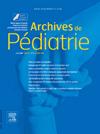Thigh and paraspinal muscles change after fusionless bipolar fixation for early onset scoliosis in type 2 spinal muscular atrophy
IF 1.3
4区 医学
Q3 PEDIATRICS
引用次数: 0
Abstract
Background
Spinal muscular atrophy is a severe, progressive autosomal recessive neuromuscular disorder associated with neuromuscular scoliosis. When bracing is not sufficient to control the deformity, early spinal surgery is required. To the best of our knowledge, no work in the literature have assessed modifications in spinal and thigh muscles of subjects with type 2 spinal muscular atrophy (SMA2) following spinal surgery.
Objective
This study aimed to better understand modifications in the spinal and thigh muscles of subjects with SMA2 and early onset scoliosis, before and after minimally invasive fusionless surgery.
Methods and settings
20 SMA2 patients with confirmed scoliosis on bi-planar low-dose X-ray were included: 10 preoperative and 10 postoperative patients with a minimal follow-up of 5 years after surgery. The surgery consisted of a bilateral sliding rod construct extended from T1 to the sacrum, through a minimally invasive approach. All subjects had fat/water separation muscle magnetic resonance imaging from the spine to the thigh. The percentage of fat degeneration was compared before and after surgery. A quality-of-life survey was performed.
Results
Fat infiltration was diffuse and symmetric in both groups of patients, and on average six times more compared to control subjects previously published at thigh level. Adductors, sartorius, and gracilis were less affected with respectively, 51%, 56%, and 57% of fat fraction before surgery. Comparing the preoperative and postoperative groups, fat infiltration was higher in sartorius and multifidus after surgery (p < 0.05). No significant difference was found for the other muscles studied. These results did not affect quality of life.
Conclusion
This is the first study to compare fat infiltration of spinal and thigh muscles of SMA2 patients before and after minimally invasive surgery. Our results demonstrate that muscles were globally preserved apart from multifidus and sartorius which were more affected.
无融合双极固定术治疗2型脊髓性肌萎缩症早发性脊柱侧弯后大腿和脊柱旁肌肉的变化:SMA2和早发性脊柱侧弯患者脊柱和大腿肌肉的变化。
背景:脊髓性肌萎缩症是一种严重的进行性常染色体隐性神经肌肉疾病,伴有神经肌肉性脊柱侧弯。当支撑物不足以控制畸形时,就需要尽早进行脊柱手术。据我们所知,目前还没有文献对脊柱手术后 2 型脊髓性肌萎缩症(SMA2)患者脊柱和大腿肌肉的变化进行评估:本研究旨在更好地了解微创无融合手术前后 SMA2 患者脊柱和大腿肌肉的变化情况:方法:20 名经双平面低剂量 X 光检查确诊为脊柱侧弯的 SMA2 患者:10 名术前患者和 10 名术后患者,术后随访最短 5 年。手术包括通过微创方法将双侧滑动杆结构从 T1 扩展到骶骨。所有受试者都进行了从脊柱到大腿的脂肪/水分离肌肉磁共振成像检查。手术前后的脂肪退化百分比进行了比较。还进行了生活质量调查:两组患者的脂肪浸润均呈弥漫性和对称性,与之前发表的大腿水平对照组相比,平均多出六倍。内收肌、腓肠肌和腓肠肌受影响较小,术前脂肪比例分别为51%、56%和57%。对比术前和术后两组,术后腓肠肌和多裂肌的脂肪浸润率更高(P < 0.05)。所研究的其他肌肉没有发现明显差异。这些结果不会影响生活质量:这是第一项比较微创手术前后 SMA2 患者脊柱和大腿肌肉脂肪浸润情况的研究。我们的研究结果表明,除了多裂肌和腓肠肌受影响较大外,其他肌肉在整体上都得到了保留。
本文章由计算机程序翻译,如有差异,请以英文原文为准。
求助全文
约1分钟内获得全文
求助全文
来源期刊

Archives De Pediatrie
医学-小儿科
CiteScore
2.80
自引率
5.60%
发文量
106
审稿时长
24.1 weeks
期刊介绍:
Archives de Pédiatrie publishes in English original Research papers, Review articles, Short communications, Practice guidelines, Editorials and Letters in all fields relevant to pediatrics.
Eight issues of Archives de Pédiatrie are released annually, as well as supplementary and special editions to complete these regular issues.
All manuscripts submitted to the journal are subjected to peer review by international experts, and must:
Be written in excellent English, clear and easy to understand, precise and concise;
Bring new, interesting, valid information - and improve clinical care or guide future research;
Be solely the work of the author(s) stated;
Not have been previously published elsewhere and not be under consideration by another journal;
Be in accordance with the journal''s Guide for Authors'' instructions: manuscripts that fail to comply with these rules may be returned to the authors without being reviewed.
Under no circumstances does the journal guarantee publication before the editorial board makes its final decision.
Archives de Pédiatrie is the official publication of the French Society of Pediatrics.
 求助内容:
求助内容: 应助结果提醒方式:
应助结果提醒方式:


